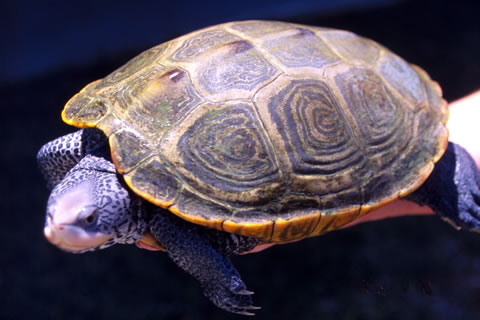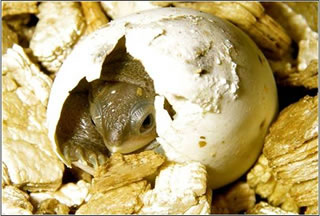 |
Canku Ota
|
 |
|
(Many Paths)
|
||
|
An Online Newsletter
Celebrating Native America
|
||
|
February 2015 - Volume
13 Number 2
|
||
|
|
||
|
Diamondback Terrapin
(Malaclemys terrapin) |
||
|
by Defenders of Wildlife
|
||
|
Diet Range Behavior
Reproduction The gender of diamondback terrapin offspring is determined by temperature – a higher nest temperature produces more females while a lower nest temperature produces more males. The hatchlings emerge from August to October and are completely on their own. Only 1 to 3% of the eggs laid produce a hatchling, and the number of hatchlings that survive to adulthood is believed to be similarly low. After hatching, some young remain in the nest during the winter although most emerge and enter the nearest body of water. Threats Climate change is also poised to bring major changes to the terrapin’s habitats and life cycle. By the end of this century, sea level is projected to rise between 2.25 feet under a low emissions scenario and up to 3.25 feet under the highest emissions scenario. Due to land subsidence in the Northeast, the effect of the rise will seem about 10 to 20% higher than the actual. Salt water incursion into brackish tidal marshes will alter their character and potentially make large areas saltier than the terrapin can tolerate. Storm surges and beach erosion threaten their preferred nesting habitats. And higher temperatures on nesting beaches could skew the sex ratios of offspring. |
|
 |
|
|
||
|
|
||
| Canku Ota is a free Newsletter celebrating Native America, its traditions and accomplishments . We do not provide subscriber or visitor names to anyone. Some articles presented in Canku Ota may contain copyright material. We have received appropriate permissions for republishing any articles. Material appearing here is distributed without profit or monetary gain to those who have expressed an interest. This is in accordance with Title 17 U.S.C. Section 107. | ||
|
Canku Ota is a copyright ©
2000 - 2014 of Vicki Williams Barry and Paul Barry.
|
||
 |
 |
|
|
The "Canku
Ota - A Newsletter Celebrating Native America" web site and
its design is the
|
||
|
Copyright ©
1999 - 2014 of Paul C. Barry.
|
||
|
All Rights Reserved.
|
||
 Named
for the diamond-shaped growth rings on its top shell, the diamondback
terrapin (Malaclemys terrapin) a turtle native to the eastern and
southern United States.
Named
for the diamond-shaped growth rings on its top shell, the diamondback
terrapin (Malaclemys terrapin) a turtle native to the eastern and
southern United States.  Mating
Season: May through July.
Mating
Season: May through July.